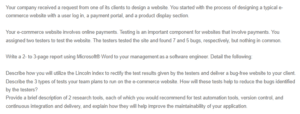Question Your company received a request from one of its clients to design a website. You started with the process of designing a typical e-commerce website with a user log in, a payment portal, and a product display section. Using The Lincoln Index for Software Testing Your e-commerce website involves online payments. Testing is an important component for websites that involve payments. You assigned two testers to test the website. The testers tested the site and found 7 and 5 bugs, respectively, but nothing in common.
Using The Lincoln Index for Software Testing
The Lincoln Index
Lincoln index is a statistical system used to estimate the total number of errors in a specific program or website. The system calculates the total number of errors based on the number of errors that software testers or developers have already found. Suppose two different software developers, for instance, try to find the total number of errors in the software. In that case, the two different software testers are likely to find different errors (Curcio, Navarro, Malucelli & Reinehr, 2018). Lincoln index comes in handy because the software will provide an accurate number of errors or bugs in the software. In a web application dealing with online payment identification, all errors or bugs are important since a small error can lead to the loss of large amounts of financing (Curcio, Navarro, Malucelli & Reinehr, 2018). Lincoln index is best used in combination with software testers to find the total number of errors in any software system.
Types of Testing to Reduce the Identified Bugs
Several types of errors can be tested using the Lincoln index, such as functional errors. Functional errors can be spotted using developers and not the Lincoln index since these errors will cause the system to fail, which does not need to be tested using statistical systems to realize that there is an error (Curcio, Navarro, Malucelli & Reinehr, 2018). The Lincoln system can be used to find the total number of security system errors or bugs that malicious users can use to hack into the payment system. If these kinds of errors are not all identified, the organization stands to lose large amounts of capital and sensitive information from the users. In turn, this will reduce the number of clients that the company gets since they will lose their reputation (Menezes, Gusmão & Moura, 2019).
Syntax errors are caused by misspelling or placing the wrong character within the program’s code. This error can cause the program to function ineffectively even though the program will still function. This error can lead to the slowing down of the program, which can become costly to the organization. System-level integration bugs can also be calculated using the Lincoln statistical system (Menezes, Gusmão & Moura, 2019). These errors are usually not easily identified since they are caused when two software components are inappropriately integrated. These errors can occur when the online payment system is wrongly integrated with the web user interface and can lead to errors in user input or processing of payment details (Menezes, Gusmão & Moura, 2019). Out-of-bound bugs are another error that can be calculated using the Lincoln statistical system. This error is usually not expected or visible in the program code but occurs when the user enters an input that is out of the expected, causing an error in the system (Menezes, Gusmão & Moura, 2019).
Recommended Research Tools
Selenium is one of the test programs that can be automated for software testing. The software can be used across various platforms, such as Windows, Linux and macOS. The software is also used to test programs written in C#, python and Perl, among other languages. The software can also be used to test web-based applications in languages such as PHP. TestComplete is software that can also be automated to test software, mobile applications and web-based programs. The software supports Java, Python, C++ and web scripting languages. The software is developed by SmartBear Software Company.
Conclusion
In summary, the Lincoln statistical system can be used to ensure that the errors that the software developers did not initially recognize are found and dealt with. The Lincoln statistical system also ensures that the software development process is completed successfully and works efficiently. Additionally, the different types of errors can cause different types of system failures.
References
Curcio, K., Navarro, T., Malucelli, A., & Reinehr, S. (2018). Requirements engineering: A systematic mapping study in agile software development. Journal of Systems and Software, 139, 32-50.
Menezes, J., Gusmão, C., & Moura, H. (2019). Risk factors in software development projects: a systematic literature review. Software Quality Journal, 27(3), 1149-1174.
